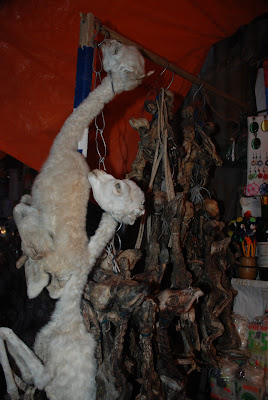| This far north and still snow-capped Andes! Illimani, the highest mountain in the Cordillera Real at 6438m & La Paz the highest capital city in the world at 3660m. |
 |
| Sagarnaga, the colonial and now tourist district. |
After some solid washing catch up and internet time, we arranged a short flight into the Amazon (over the 26 hour bus ride) from where we arranged a jungle pampas trip (next blog), then returning to La Paz again. So we had a couple of days either side of the jungle trip to explore La Paz.
| Sagarnaga |
A favorite for us was the Coca Museum, which magnified the history production and consumption of the small leaf. Of course, the leaves have played a major role in the culture and economy of Bolivia to this day. The cocaine component was particularly interesting - with an estimated 9000 small cocaine producing laboratories hidden deep in the Bolivian jungle!
As prevalent as coca leaves are (legally for indigenous purposes), you need loads of the stuff to extract the illegal component. Some 330kg takes a lab of 10 poorly paid men 12 hours to produce 1kg of cocaine paste, which is then further refined to the illegal powder. Amazing how much info was out in the open about the drug-trade with detailed illustrations about where the trafficking occurs in Bolivia!
Other history of the coca leaf was also interesting, most famously the use of cocaine extract in the original brew of Coca Cola (circa 1900's). The museum claims Coca Cola is still legally purchasing circa 200 tonnes of coca leaves per year for flavouring....
 |
| Llama foetuses at the witches market - buried underneath a new house to bring good luck... |
 |
| Plaza Pedro D Murillo |
 |
The Worlds Most Dangerous Road! A big tourist draw card and must-do when in Bolivia. We were really looking forward to the decent via bicycle!
 |
| Yes this is actually Clare (L) and I (R), standing atop the WMDR in our hardcore downhill gears! |
It was extremely harrowing in places, with our guide pointing out crosses marking the sites of vehicle accidents; it was easy to understand how such a road with such drivers could afford its famous title. When this was the main road, which was up until 2007, it claimed an average of 100 lives per year.
 |
| Hardcore biker/photographer, that's my Fiance! |
 |
| Probably the most famous image of the ride. |
 |
| The bottom! Circa 3 hours down including play-lunch and photo stops, probably safer and almost faster than driving down! |







No comments:
Post a Comment